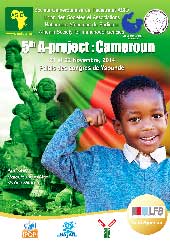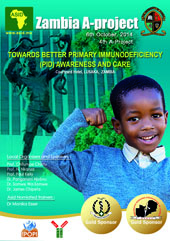Elfeky R1, Radwan N1, Hassanein SM2, Reda SM1
1 Paediatric Allergy and Clinical Immunology Unit,
2 Paediatric Neurology Unit, Children’s Hospital, Faculty of Medicine, Ain Shams university, Cairo, Egypt.
Background: Griscelli type 2 (GS2) is a rare disorder induced by mutations in RAB27A gene and characterized by oculocutaneous hypopigmentation and variable cellular immunodeficiency1. The Silvery gray hair with large, clumped melanosomes on microscopy of hairshafts are diagnostic. The commonest complication leading to mortality includes lymphohistiocytic proliferation in various organs, including the brain.2It is a fatal disease unless HSCT is commenced. Age at presentation and severity of disease varies within the same family members. Boys might have a severe disease than girls. IVIG might delay the development of HLH in GS2.
Herein we report two consanguineous families with variable initial clinical presentation. In both families, affected siblings had clinical stigmata of GS2;albinism, silver hair, large irregular melanin and normal immunological profile. Both families had an identified RAB27A mutation.
Family 1:A two-year old girl of non-consanguineous parents presented with recurrent attacks of gastroenteritis and persistent oral Candida infection since birth. Her elder brother died at the age of 10 months out of refractory hemophagocytic lymphohistiocytosis (HLH) with no previous history of recurrent infections.
On examination: The patient had delayed motor milestones, unsteady gait, and generalized hypotonia. Her weight and height were below the 5th- centiles for age. She had generalized lymphadenopathy and hepatosplenomegaly. Investigations revealed no abnormalities in blood count and blood film as well as lymphocyte subsets. Also, her serum immunoglobulin levels were normal for age. She received antibiotics for prophylaxis and treatment of infections. Unfortunately, there was no available matched donor within the family and the patient died at the age of 2.5 years of HLH and intracranial hemorrhage due to thrombocytopenia.
Family 2: A female infant aged 11 months presented to hospital with bronchopneumonia and partial albinism with silver hair.Her weight and height were normal for age, but she had marked ataxia, hypotonia, but no organomegaly. The laboratory investigations showed no abnormalities in her blood count, lymphocyte subsets or serum immunoglobulin levels. There was no laboratory evidence of HLH. Brain MRI showed diffuse cerebellitis. Hair shaft examination showed irregular scanty melanin pigments (Figure). On admission, she received parenteral antibiotics and IV methylprednisolone for 5 days. Intravenous immunoglobulin G (IVIG) was started on the second week of admission at a dose of 1g/kg. The patient showed a very good response of treatment and was discharged after one month with a residual neurological deficit .She was maintained on monthly IVIG till her death at the age of 4 years of HLH.Her junior brother had the same phenotype and died at the age of 4 months with HLH.

References:
- Shamsian BS, Norbakhsh K, Rezaei N, Safari A, Gharib A, Pourpak Z, et al. A NovelRAB27AMutation in a Patient WithGriscelli Syndrome Type . J InvestigAllergolClinImmunol. 2010; 20(7): 612-615.
- Manglani M, Adhvaryu K, Seth B. Griscelli Syndrome - A Case Report.INDIAN PEDIATRICS; 41: 734- 736.



























